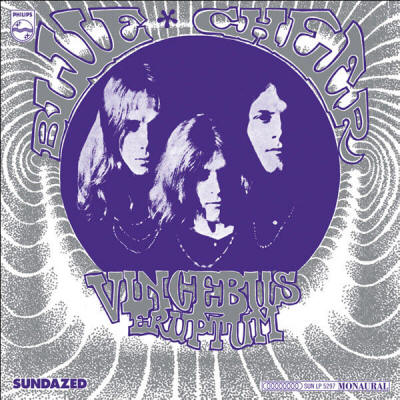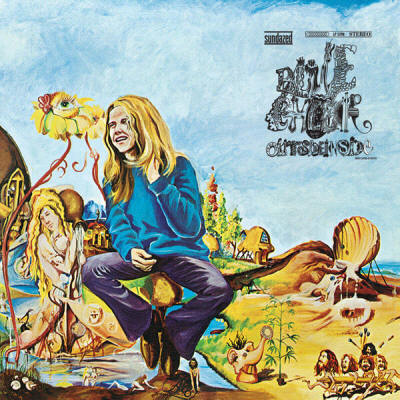|
You are reading the older HTML site Positive Feedback ISSUE 49may/june 2010
Two Classic Vinyl Re-issues
by the Great
Blue Cheer on Sundazed Records
Vincebus Eruptum (mono) [Philips PHM 200-264/Sundazed LP 5297]
Outsideinside [Philips PHS 600-278/Sundazed LP 5298] This being an audiophile 'zine one might expect that the records appearing herein to be judged with sound quality as perhaps not the main focus of the review, but certainly a major factor when considering whether they should be recommended for inclusion in one's collection. Well, here we have two albums that despite their lack of just about any evidence of audiophile-approved traits (other than the vinyl's modern-day pressing quality and the excellent transfer from original master tapes to vinyl), should be a mandatory purchase for anyone even slightly interested in the conception and gestation of hard rock/psychedelic blues/heavy metal that these landmark albums brought into the world in 1968. These two Marshall-stack-laden slabs are not just forbearers of what would become the genre that is now considered heavy metal, but quintessential examples of excellent rock music, period. Blue Cheer formed in 1966 in their hometown of San Francisco, and within a year settled into a power-trio of unequaled sonic might. Their first album, Vincebus Eruptum was recorded late in 1967 and released early the next year on Philips, and later in '68 their second album Outsideinside was released. One would think that being located in San Francisco this band would get caught in the torrent of flower-power ideology that was flowing forth in and around the city, but according to Blue Cheer's bassist and vocalist Dickie Peterson, "We were the ugly stepchildren. Everybody in San Francisco scene was all kiss babies and eat flowers. We were sort of kiss flowers and eat babies". This less than hippy attitude is made obvious as soon as the stylus traces the first grooves of either of these two records. OK, so you're not going to be able to use either of these albums as demonstration discs. But it makes little sense depriving oneself just because at certain points these albums sound as if they were recorded from the next room through an open door. It's a shame that these records don't have the sound quality of say, Led Zeppelin's first two albums that were released during the next two years. One might suspect that the less than state-of-the-art facility that Blue Cheer used for the first album in their native San Francisco might have had something to do with the the less than reference quality sound. Yet the follow-up Outsideinside was recorded at some top flight studios on both coasts, and even sported some pretty famous engineering talent including the illustrious Eddie Kramer. Yet this album's sound quality is also second-rate. It was most likely due to the challenges of recording a band with all of their amp's volume controls set to 11 the entire time. It has been rumored that the band had to relocate to a different studio during one of the recording sessions because of noise complaints from the neighborhood around the facility. Yet despite these sonic limitations, and especially on the mono Vincebus Eruptum, the term "wall-of-sound" is very, very apt. And because of these excellent transfers performed by Sundazed Records, the best I've ever heard from any other pressings on both vinyl and CD. An added bonus is that the album sleeves are also top-notch, the embossed front cover of the first and gatefold of the second are exact reproductions of the originals. I have the impression that I'm hearing exactly what was on the master tapes as they were recorded. I doubt very much that the band and the studio staff set out to make the resulting sound of these albums anything but what they intended, and with these slabs of wax, at least when being played on my system, it is easy to get the impression that the air in and around the recording studio during these sessions became super-saturated with sound waves—and if you've ever experienced an overwhelmingly loud band in a small space you'd realize that the "P" in SPLs (Sound Pressure Levels) can be brutal. It would be a shame to purchase one of these albums without the other. But since the best place to start is usually the beginning, Vincebus Eruptum should be spun first. And the fact that it is a monaural pressing is fabulous, not just because back in those heady days stereophonic sound was still in its infancy with regards to rock music. This is not to say that many great stereo rock records weren't released—of course there were. But the the truth is that in most cases they really weren't truly "stereophonic" as classical releases were, it was simply just two-channel sound. This was at least partially because at most four-track tape used in most recording studios, so during mix down it was just a matter of deciding which and how much of these tracks ended up in which of the two speakers. There are some great rock albums from around the same period that had engineers that realized that a nice stereo spread could be obtained by using a pair of overhead mics for the drum set. But many didn't get the memo, and the drums were relegated to one track—and to add insult to injury were panned to one side. The overused practice of pseudo-psychedelic swooping between the speakers, especially the lead guitar hardly makes a record "stereo", so things just ended up sounding just like plain old dual-mono. Sundazed Records' outstanding pressing of the reissue of Vincebus Eruptum from the original mono master tape is practically a revaluation, especially to the ears belonging to yours truly that has only heard the stereo pressing throughout my adult life. The mono version is so much more of an "in your face" experience. As it should be. Vincebus contains six songs, half of them are cover tunes. Side one starts with the classic Jerry Capehart/Eddie Cochran "Summertime Blues", which was to be Blue Cheer's only "hit" record (it peaked at #14 on Billboard's pop singles chart). Next is the chestnut "Rock Me Baby", and the side ends with the now classic Peterson bruiser "Doctor Please", with his lyrics taking an anti-recreational drug stance and at the same time proclaiming an unrequited love for a member of the opposite sex, but you have to squint your ears to decipher the lyrics under the guitar/bass/drums blitzkrieg. Side two begins its onslaught with Peterson's "Out Of Focus", with its overdubbed guitar lick madness that rightfully earned guitarist Leigh Stephens a fervent underground following. Next up is the requisite "Parchment Farm", but side two ends with the barnburner that is the Dickie Peterson opus "Second Time Around". Thankfully, the concept of a "power ballad" never entered the members of Blue Cheer's minds, so throughout the album's brief thirty-two minute playing time one barely gets the opportunity to come up for air. Outsideinside's recording quality is a bit better than Vincebus, but it has little to do with it being a "stereo" pressing. Like I said, it was recorded at some noted studios by some renowned engineers but still ends up sounding rather lo-fi. But despite the lack of fidelity the massive sound of the band members in all their glory are still decipherable through one's speakers. Over the years I've met legions of fans of this album, and although its sound quality rarely comes into question, what they do agree upon is that it is one of the best hard rock (electric-power-blues?) recordings ever committed to vinyl. Throughout the years I've gone back and forth in regards to whether it is a better album than Vincebus, but eventually realized that that debate is a waste of my time—they both deserve equal time on my turntable. But I do sometimes favor Outsideinside for a few reasons, and major among those is the more concise, developed songwriting made even more amazing that the album was released such a short time since the first. The songs are shorter, leaving less room for extended improvisation, leading to Mr. Stevens' guitar solos being more focused mini-explosions. And this time eight of of ten songs are original compositions. Immediately upon playing the opening "Feathers From Your Tree" one can hear the confidence not only in its writing, but the massive "whomp" factor coming into play—thanks in large part to the pounding of drummer Paul Whaley. The third song is Peterson's bluesy, flanged, rocking "Just A Little Bit", another of the eight originals that compose the ten masterpieces. It's worth mentioning again that the purchase of both these albums should be mandatory for all even slightly interested in this period of rock 'n' roll.
|


